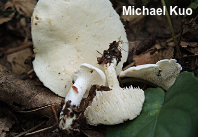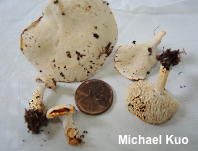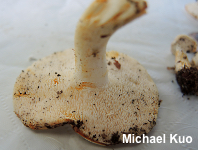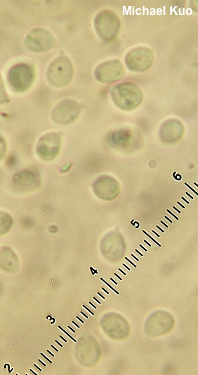| Major Groups > Toothed Mushrooms > Hydnum > Hydnum alboaurantiacum |

|
Hydnum alboaurantiacum [ Basidiomycota > Cantharellales > Hydnaceae > Hydnum ... ] by Michael Kuo At least two small, white species of Hydnum appear in eastern North America: Hydnum albidum, fairly widely distributed from Nova Scotia to Veracruz, and Hydnum alboaurantiacum, known so far only from the southern Appalachians. The species are clearly separated by their ITS sequences, but separating them without a DNA lab is a little trickier, especially since their microscopic features are similar. The best morphological separator, according to Swenie and collaborators (2018) is the fact that Hydnum alboaurantiacum "quickly stains bright orange within minutes wherever handled, while H. albidum stains much less vividly brown-orange, sometimes only hours after handling." So I have placed the illustrated and below-described collection under Hydnum alboaurantiacum on the basis of its North Carolina location and the fairly strong and bright orange staining, which seems to match the illustrations provided with the original description of the species by Swenie and collaborators (2018). Hydnum subtilior is somewhat similar, too, but is usually pale orange rather than white, and a bit larger; it also has much larger spores. Thanks to Sherwood Forest Friends for facilitating collection of specimens. Description: Ecology: Probably mycorrhizal, but with precise associate undetermined; recorded in mixed hardwood-conifer forests; growing gregariously on the ground; July and August; known from the southern Appalachians (West Virginia, North Carolina, and Tennessee). The illustrated and described collection is from North Carolina. Cap: 2–5 cm wide; broadly convex, becoming planoconvex; dry; soft; bald but kid-leathery to the touch; whitish to white; bruising orange, especially along the margin. Undersurface: Not running down the stem, or only beginning to do so; covered with densely packed, soft spines that are round in cross-section and measure 1–3 mm long; whitish; bruising orange. Stem: 2–4 cm long; 4–6 mm thick; dry; bald; whitish; bruising orange, then slowly brownish orange. Flesh: Whitish; slowly orangish when sliced; brittle. Odor and Taste: Not distinctive. Chemical Reactions: Iron salts negative on spines. Microscopic Features: Spores 4–5 x 3–4 µm; ellipsoid, with an apiculus; smooth; hyaline in KOH. Basidia 4-sterigmate; 35–40 x 6–8 µm; subclavate. Pseudocystidia 30–40 x 3–6 µm; cylindric with rounded apices; thin-walled; smooth; hyaline in KOH. Pileipellis not clearly differentiated; cap surface hyphae tangled, 4–6 µm wide, ochraceous to golden in KOH, with clamp connections. REFERENCES: R. Swenie & P. B. Matheny, 2018. (Swenie et al., 2018.) Herb. Kuo 08101907. This site contains no information about the edibility or toxicity of mushrooms. |
© MushroomExpert.Com |
|
Cite this page as: Kuo, M. (2020, September). Hydnum alboaurantiacum. Retrieved from the MushroomExpert.Com Web site: http://www.mushroomexpert.com/hydnum_alboaurantiacum.html |



